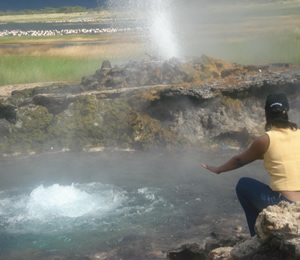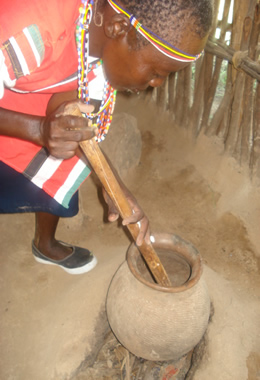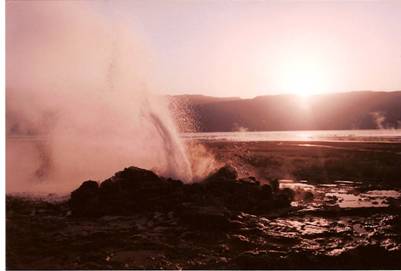|
Find Your Trip
....................................................................................................................................
东非大裂谷带湖区
Lake Bogoria
 Use the Great North Road that passes through Nairobi and
Nakuru. Traveling from Nairobi to Nakuru takes 2 hours maximum with
a good stop over point at the Delamere shops on Naivasha's
outskirts. The scenery from then on consists mostly of the gentle
highlands and valleys of the Great Rift Valley. Use the Great North Road that passes through Nairobi and
Nakuru. Traveling from Nairobi to Nakuru takes 2 hours maximum with
a good stop over point at the Delamere shops on Naivasha's
outskirts. The scenery from then on consists mostly of the gentle
highlands and valleys of the Great Rift Valley.
Plenty of public service vehicles from major towns
travel to Nakuru, which is also the fourth largest town in Kenya. It
is a busy and thriving local centre with a bustling market. We stop
over for meat that takes forever to come at a banda just outside
Nakuru. Then it's on to less habited lands and small towns like
Mogotio where honey is sold along the roadside at pretty good rates.
From here a few potholes slow us down before getting to the
heavily-signed junction at which we turn right towards Bogoria.
Lake Bogoria hotel
We head downhill, seeing Lake Bogoria in the
distance, before finally arriving at our destination- the Lake
Bogoria hotel.
I wasn't disappointed. The lodge covers immense
grounds that are aptly located away from the hustle and bustle of
town. So peaceful are they that ostriches and monkeys have made
their home here.
The swimming pool is one of the biggest in Kenya
(half Olympic size), and is perfect to spend your days in because
daytime temperatures get very high.
In 2004 the lodge premiered a new event in Kenya's
cultural calendar- the Great Rift Cultural Festival week. This is
the first ever event in Kenya that aims to market the unexploited
potential of the Central rift western circuit as a tourist
destination, showcasing a wide variety of performances and talent.
The cultural menu includes displays of the homesteads, artifacts and
dress of the central rift valley communities, traditional sports and
video shows on relevant culture.

I got a taste of the offerings from the traditional
food festival with African beats playing in the background. First up
is a glass of Mursik, a traditional drink from the Kalenjin
community. The sour taste of this milky drink takes getting used to.
Mursik is made by lining the inside of a gourd with ash from the
burning branch of a special tree, after which the bigger charcoal
residue is shaken out. Then, boiled cooled milk is added and the
mixture is left to ferment over 3 days. The thin layer of ash gives
the milk its grey colouring.
After dinner dancers from the Tugen and Njemps
communities entertain us. Anyone is allowed to join in to the
gyrations of these rarely seen dances. And once the scheduled dances
are over, the traditional dancers prove to us that they are quite
versatile in their artistic maneuvers, dancing to more modern
secular hits.
Hot spa pool
Next morning I get to try out a unique feature of
the Lake Bogoria hotel- the only hot spa pool in Kenya and the
second in Africa. A naturally flowing river feeds this pool from hot
springs, so the water remains at a constant temperature of about 37
deg centigrade. It feels like a hot bath, so with the hot daytime
temperatures you may find it uncomfortable to swim for long during
the day.
Cool off with a refreshing cocktail at the bar like
the Bogoria special, a drink made from pineapples, pawpaw and melon
with a hint of Sprite. All fruits are freshly-picked from the area.
After that it's time for a break in my cottage
before lunch. The rooms are either standard or fully furnished VIP
rooms. The cottages are very popular with honeymooners.
Entertainment
The advantage of staying here during the festival
is that entertainment is in plenty especially at night both before
and after dinner. We enjoy more cultural performances featuring
acrobatics, and dance routines. Then we make merry around the
bonfire, before taking another dip in the hot spa pool. At night it
feels wonderful- you can actually stay in all night- which we did,
till the sun rose at exactly 6:05a.m.
Lake Bogoria National reserve
The Lake Bogoria National Reserve is 5 minutes'
drive from the lodge. Private transport is recommended as no public
vehciles get this far.
What we see is well worth the trip. This view has
been described as nature's studio because of the dramatic backdrop
of the Eastern wall of the Great Rift Valley with the contrasting
colours of the deep blue lake waters and grasslands in the
foreground. This escarpment forms one of Kenya 's most picturesque
backdrops.
Geysers 
Lake Bogoria is still volcanically active. Its
sulfuric hot springs and spouting geysers are popular for their
therapeutic values. These powerfully gushing waters have extreme
temperatures so you need to be cautious. Warning signs tell it all.
|
Did you know...?
- Lake Bogoria was originally named Lake
Hannington after an early bishop who explored the area
- It is alkaline and has no outlet
- Its intense evaporation has led to high
levels of salt and minerals. As a result it has no fish but
is rich in blue-green algae, which the flamingos love
- Millions of flamingos make their home here
when they are not in the other Rift Valley lakes. Their pink
plumage makes a truly beautiful sight.
|
Lake Bogoria is not often visited by tourists hence
it is a prime area to get away for picnics and lessons in
conservation. The reserve boasts an ecosystem that allows humans,
domestic animals and wildlife to co-exist peacefully. It is home to
the endangered Umbrella tree, which is one of the few trees whose
branches meet at right angles. As such it is used to make racks for
hanging coats, and traditionally it is used to hang beehives.
On our way out we spot the Grants gazelle, herds of
common Zebra, and a male ostrich protecting his young from the hot
sun. Ostriches are very responsible parents, with equal care given
by both the male and female in the upbringing of their young.
 The elusive Kudu The elusive Kudu
Here's an interesting fact about the many anthills
that dot the park. Did you know that anthills have one of the most
advanced air circulation systems? The hotter the weather, the taller
the anthills grow, based on the principal ‘the higher you go the
cooler it gets'. Car and refrigerator manufacturers as well as air
conditioning companies avidly study them, and local communities
observe them to know how hot the weather will be.
Accommodation rates and
images
| 


